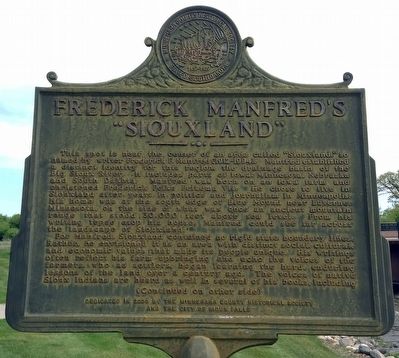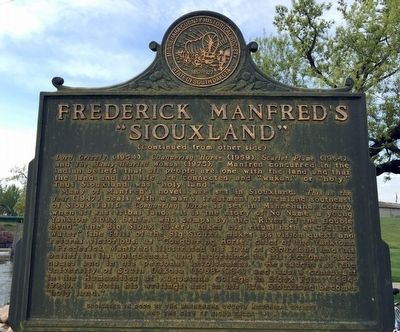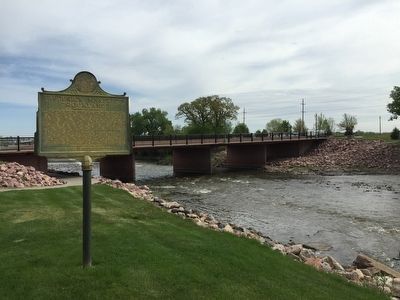North End East in Sioux Falls in Minnehaha County, South Dakota — The American Midwest (Upper Plains)
Frederick Manfred’s “Siouxland”
For Manfred, Siouxland contained no rigid state boundary lines. Rather, he envisioned it as an area with distinct social, cultural, and economic values that made its people unique. His writings often reflect his farm upbringing and echo the voices of the farmers who as settlers, began learning the hard, enduring lessons of the land over a century ago. The voices of native Sioux Indians are heard as well in several of his books, including Lord Grizzly (1954), Conquering Horse (1959), Scarlet Plume (1964), and The Manly-Hearted Woman (1975). Manfred concurred in the Indian beliefs that all people are one with the land and that the land and all life are connected and “wakan,” or “holy.”
Many of Manfred’s novels are set in Siouxland. This is the Year (1947) deals with a man’s treatment of farmland southeast of Sioux Falls. Conquering Horse is set in Minnehaha County when it was tribal land. It is the story of No Name, a young Yankton Sioux brave, who camps by the “River of the Double Bend” (the Falls of the Big Sioux), makes his vision quest, and returns victorious, as “Conquering Horse,” chief of the Yanktons.
Frederick Manfred illustrated his love of Siouxland and his belief in its uniqueness and importance in his fictional place names and in his personal involvement. He taught at the University of South Dakota (1968–1984) and was a consultant in the Humanities at Augustana College in Sioux Falls (1984–1994). In both his writings and in his life, Siouxland becomes “holy land.”
Erected 2000 by Minnehaha County Historical Society and the City of Sioux Falls.
Topics. This historical marker is listed in these topic lists: Arts, Letters, Music • Native Americans • Settlements & Settlers. A significant historical year for this entry is 1954.
Location. 43° 33.543′ N, 96° 43.297′ W. Marker is in Sioux Falls, South Dakota, in Minnehaha County. It is in North End East. Marker can be reached from the intersection of East Falls Park Drive and North 2nd Avenue. It is riverside at Falls Park at the turn the Sioux Falls Bike Trail where it climbs up to the bridge to cross the river. Park at the first parking lot for the Falls Park Visitor Information Center. You should be able to see the marker from the far end of the parking lot. Touch for map. Marker is at or near this postal address: 131 E Falls Park Dr, Sioux Falls SD 57104, United States of America. Touch for directions.
Other nearby markers. At least 8 other markers are within walking distance of this marker. Artisans at the Falls (about 300 feet away, measured in a direct line); In the Name of Progress (about 300 feet away); Human Timeline (about 400 feet away); The Dubuque House (about 500 feet away); Monarch of the Plains (about 500 feet away); The Promise of Electricity (about 500 feet away); Falls Park Bridge (about 600 feet away); Prison Quarry (about 800 feet away). Touch for a list and map of all markers in Sioux Falls.
Also see . . . Wikipedia entry for Frederick Manfred. “Lord Grizzly, the first of ‘The Buckskin Man Tales,’ was the first work Manfred published under his new name. It was a best seller and one of the finalists for the National Book Award in 1954.” (Submitted on December 16, 2015.)

Courtesy Amazon.com Product Illustration
5. Frederick Manfred — Conquering Horse
Amazon.com audiobook, online Audible book, paperback or hardcover. Blurb: “High on a remote butte, a young Sioux waits. Though daring in battle, skillful, and strong, he cannot be a man until his spiritual vision comes. When it appears, he must interpret it correctly to know who he is, and he must deserve it or continue to be called No Name. No Name has his vision, a glowing white mare who walks among the stars. She tells No Name his destiny and how to achieve it. He must pass through hostile camps, storm, and fire, risking his life many times to become Conquering Horse, chief of the Sioux.” “Mr. Manfred’s novel carries the feel of open country, of grass and wind, sun and rain, moonlight and starlight. . . . It is harshly real.”—New York Herald Tribune
Click for more information.
This website may earn income if you use this link to make a purchase.
Click for more information.
This website may earn income if you use this link to make a purchase.
Credits. This page was last revised on February 16, 2023. It was originally submitted on December 16, 2015, by J. J. Prats of Powell, Ohio. This page has been viewed 563 times since then and 15 times this year. Last updated on January 12, 2016, by Ruth VanSteenwyk of Aberdeen, South Dakota. Photos: 1, 2, 3, 4, 5. submitted on December 16, 2015, by J. J. Prats of Powell, Ohio. • Bill Pfingsten was the editor who published this page.



